251 S. Main St. Los Angeles, CA 90012 | map |
The news: It's alive again as The Kult, advertised as "the ultimate event space" for film, fashion and more. Chris Nichols has the background on new proprietor Viktoriia Vlasenko in "Shuttered Downtown Theater Comes Back as The Kult," his October 25, 2024 story for Los Angeles magazine.
Opened: The first venue on the site opened in 1925 as the Arrow Theatre with George Carpenter as the initial owner. The location is the west side of the street mid-block between 2nd and 3rd. Photo: Bill Counter - 2024
The original structure was rebuilt as the ImaginAsian Center in 2007. It soon became the Downtown Independent, a venue that was in operation until early 2020. In July 2024 it became The Kult, a showcase for film, dance, fashion and theatre events operated by Viktoriia Vlasenko.
Online: www.thekultla.com | on Instagram | Also see Viktoriia Vlasenko's design site: vikvdesign.com | Still up but inactive since 2020: www.facebook.com/downtownindependent
Phone: 442-327-8023
Original architect: John E. Kunst. Noirish Los Angeles contributor Tovangar 2's Noirish post #30848 includes a copy of the October 14, 1924 building permit, signed by the architect.
Seating: 500. It had a balcony and a cry room.
A fire in October 1938. Thanks to Ken McIntyre for finding this news report.
A December 31, 1941 ad in the L.A. Times. 5 big shows that day showing off the "New Year's Nudies." Thanks to Ken McIntyre for locating the ad for a post on Photos of Los Angeles.
Closing as the Linda Lea: After decades of successfully running both Chinese and Japanese product at different times, the Linda Lea closed in the mid-80s. Part of the issue was competition from three theatres on the westside running Japanese product. After closing, the building was owned by Metropolitan News, who had an office on Spring St. They were using it for storage of files.
The rebuild: The Linda Lea was nearly demolished in 2007 to make way for a new theatre. The two side walls and half of the roof structure are the only things that would remain from the original building. The project was discussed in a March 3, 2007 L.A. Times article by David Pierson:
"Curtain Rises Again in Little
Tokyo - Downtown's first new theater in more than 20 years will replace
the once-popular Linda Lea. Like its predecessor, it will feature Asian
films. For three decades, the
Linda Lea theater sat empty and boarded up on the edge of Little Tokyo,
with the image of a kimono-clad woman looking down like a ghost from the
marquee. In its heyday, the theater was among the nation's premier
exhibitors of Japanese movies. But as downtown L.A. declined, so did the
Linda Lea.
"Crews completed demolition of the theater this week, and the act marks
both an end and a beginning. A new movie theater will soon rise on the
site, the first downtown in more than two decades. And like the Linda
Lea, it will show movies from Asia. When workers were gutting the cinema
on Main Street, they made a surprising discovery hidden behind the
drywall above the crumbling venue's pitch-dark balcony and projection
room: 11 Japanese movie posters with cherry blossom festival and samurai
scenes more than half a century old and in remarkably good condition.
The posters provide a tangible reminder of the theater's history. They
were a welcome find, the property's owners said.
"'It was so exciting because we're trying to preserve as much as we
can,' said Sue Ann Kirst, who with her husband owns Cinema Properties
Group, which bought the theater two years ago. 'Because of our proximity
to Little Tokyo and Chinatown and the history of this place, we wanted
to keep an Asian American theme.' Kirst struck a deal with an Asian
American multimedia company headquartered in New York named ImaginAsian
that runs a 24-hour cable television network and a cinema in midtown
Manhattan. The company will operate the new theater, which will be
called the ImaginAsian Center. It is scheduled to open late in the
summer.
"The goal is to lure not only young and trendy people who inhabit
downtown's lofts and condos but also Asiaphiles and Asian and South
Asian Americans who want to see first-run movies from Hong Kong, South
Korea, Japan and India. Kirst and ImaginAsian believe Asian pop culture
has enough of a following to support the venture. The new center will be
a modern steel-and-glass building containing a theater with stadium
seating for 256, a cafe, a mezzanine and space for live performances. It
was designed by Hodgetts & Fung Design Associates, an L.A. firm
that restored Hollywood's Egyptian Theater and the new shell at the
Hollywood Bowl. It will be a far cry from the original building's
configuration when it opened in 1924 as the Arrow Theater.
"Workers over the last few weeks have unearthed Art Deco-era blocks with
fleur-de-lis patterns, numbered in the back to form an intricate design
on the building's old facade. At some point, the building was said to
have been a Japanese burlesque house. The Linda Lea opened in the late
1940s, not long after most of its Japanese American patrons were
released from World War II internment camps. With its pastel plastic
facade depicting butterflies and with the woman in the kimono, the Linda
Lea was nearly the only place in L.A. to catch samurai flicks or yakuza
thrillers with English subtitles.
"'These were B movies from Japan,' said Jim Matsuoka, a regular there in
the late 1950s and early '60s. 'It had that down-home neighborhood
feeling. They had a popcorn machine with a red heat lamp. It was nothing
like these movie theaters in the mega malls.' Matsuoka, a
second-generation Japanese American, said the films were his only
contact with his parents' homeland. He said most of the movies shown at
the Linda Lea ended in a blood bath and reckons he wrongly developed an
impression of Japan as violent. 'I wondered how anyone there could have
been alive after watching these movies,' said Matsuoka, 70.
"One time, reality and film seemed to merge for Matsuoka. During a visit
to the Linda Lea, he noticed one of his aunts sobbing in the movie house
after watching a film about the yakuza, Japanese organized crime. When
Matsuoka went home to tell his mother what he saw, she reluctantly told
him that his great-uncle had been a yakuza member. 'She was neglected by
him and was overcome by the movie,' Matsuoka said.
"Those days in the '60s were said to be the theater's best. Matsuoka
remembers full houses and many other nisei — second-generation Japanese
Americans — wanting a taste of their culture. But later years were
harsh. Japanese theaters showing newer movies began to sprout on the
Westside. Other Japanese programming was available on tapes and TV. The
Linda Lea's patronage began to decline, and it closed in the early
1980s. The theater was bought by the Grace family, which owns the
Metropolitan News Co. based nearby on Spring Street. The family used it
to store files.
"When Kirst's company took over the property, it had to clean up the
mess made by thousands of pigeons, a leaky roof and squatters who lived
in the projection room. When workers tried to take down the plastic
facade in one piece, it cracked. The hot-riveted steel trusses that form
the framework for the ceiling were left untouched after they were found
to be structurally sound.
"Workers also found Filipino handbills from the days when the theater
was known as the Aztec, paper lanterns and a sign written in Japanese
that read, 'No Standing in the Hallway.' Kirst said the Japanese posters
were probably protected from damage by being rolled up and stored in an
area surrounded by plaster and drywall. They measure 24 by 36 inches
and appear to be hand-tinted from black-and-white photographs. They show
dramatic actors in heavy white makeup prepared to battle with swords
and women dancing with traditional fans.
2007 project architects: Hodgetts & Fung, who also did the 1998 Egyptian Theatre renovations.
Reopened: December 1, 2007 as the ImaginAsian Center. The developer, Cinema Properties Group, had purchased the building several years earlier from the Grace family, owners of Metropolitan News. ImaginAsian was a multinational media group that also operated a theatre in New York.
Seating at the time: 222 in the main auditorium. A separate event area upstairs was used for a second screening room with a capacity of about 30.
Projection at the time: The theatre was DCP capable and also had two Simplex XL 35s. Also in the booth were two 35mm Tokiwa projectors on LP Associates 3Kw Xenon consoles. Those Japanese machines were fitted with 16mm attachments on the front. Projection in the second upstairs room was from a ceiling mounted digital unit.
Holly Woodlawn making an appearance to promote "Beautiful Darling" in 2011. Thanks to Ken McIntyre for locating this May 6 ad for a post about the theatre on the Ken's Movie Page Facebook group.
Covid era closing: The theatre closed due to Covid restrictions in March 2020 and the management at the time didn't reopen it.
After acquisitions in 2015 and 2016 everything on the west side of the 200 block (except for the Higgins) is now owned by the L & R Group of Companies, operators of Joe's Auto Parks and other ventures. They already operate two lots on the west side of the block. Other 2016 stories about the limbo of the block, largely focused on The Smell, not the theatre, are on Southern California Public Radio and LAist.
Status: Viktoriia Vlasenko reopened the theatre in July 2024 as a theatrical venue, fashion showroom and events space called The Kult.
Chris Nichols had the background on new proprietor in "Shuttered Downtown Theater Comes Back as The Kult," his October 2024 story for Los Angeles magazine. He notes:
"Viktoriia Vlasenko is a Ukrainian fashion designer who has worked for Cirque du Soleil, costumed more than 50 films and dressed stars for the red carpet... Vlasenko arrived in Los Angeles in 2018, hoping to continue her work in film. 'For the time that I’m here, I didn’t see the movie industry in good shape,' she says. 'It takes time to build connections, and then COVID hit, and the industry is almost dead. After the recovery, I got to be in the union and then… strikes.'
"With so many photo studios and fashion designers located downtown, Vlasenko started looking around for a venue where she could build a cultural center and a community around film, music, and fashion. She found the abandoned theater and decided to call it The Kult.... Vlasenko expects to show classic and indie movies and host film festivals although there are now floor cushions where there were once theater seats. She also has plans for live concerts, fashion shows, and a rock opera or at least the after-parties from larger venues."
In late July the theatre hosted the World Culture Film Festival. On October 19 and 20 it was the Independent Festival of Russian-Speaking Drama and Film, aka Echo Lubimokva.
The Regal Cinemas at L.A. Live, and the Alamo Drafthouse at the Bloc are the only downtown Los Angeles theatres regularly running movies.
Lobby views:
early 20s - Looking north toward 2nd before the Arrow Theatre's construction. Note the nine single story storefronts in the middle. The first five were still there after the Arrow was built, the next two were demolished for the Arrow, two remained north of the Arrow. That lighter colored one without the awning most likely had been the location of the Crystal Theatre. Thanks to Ken McIntyre for finding the photo for a post on the Photos of Los Angeles Facebook page.
c.1930 - Looking south toward the Arrow Theatre. The storefront this side of the Arrow had once been the home to the Crystal Theatre, 247 S. Main. It's a photo in the Los Angeles Public Library collection.
c.1937 - A photo by Herman Schultheis in the Los Angeles Public Library collection.
1939 - A detail from the 1939 Dick Whittington Studio photo above. Note the the strangely-sized marquee added to the original facade.
1939 - Another detail from the Dick Whittington photo. At this point they were advertising two Spanish language features plus a stage show for 15 cents -- despite the old price still being on the roof sign.
1940 - A Pacific Electric streetcar hooked this guy's bumper and sent him driving into what was then called the Azteca. Thanks to Ken McIntyre for finding the photo that was in the November 20 L.A. Times.
c.1954 - Looking north on Main from 3rd St. It's a photo in the California State Library collection. Their set also includes four other Main St. views.
1956 - The back end of the Linda Lea is seen on the right side of this Palmer Connor slide from the Huntington Library collection. The building on the left was the Workman Block at 230-234 S. Spring. There's a parking garage now on that site.
c.1960 - A photo by Ralph Crane for Life with the Linda Lea over on the right. It was shot in front of the Union Rescue Mission when it was still on the 200 block of Main. It's on Google/Life images. Thanks to Noirish Los Angeles contributor Tourmaline for including this shot on Noirish post #35742. Many other Life photos are on the post, mostly about restaurants. At the bottom, however are several Main St. photos, mostly of crowds outside the Union Rescue Mission.
c.1970 - Looking south toward the theatre from 2nd St. On the right that's a look at the Higgins Building, pre-renovation. Many thanks to L.A. transit historian Sean Ault for sharing the photo from his collection.
1983 - A photo from the now-vanished American Classic Images website.
c.1985 - A look at the theatre after closing taken by cinematographer and filmmaker Gary Graver. Thanks to Sean Graver for use of the photo. See many of the photos of dying theatres Gary took in the 80s in two compilations on YouTube: "Second Run - part 1" and "Second Run - part 2"
1998 - Thanks to Cinema Treasures contributor Socal09 for the photo. It appears on the site's page about the Linda Lea.
c.2001 - A facade view by Martin of Stuttgart, Germany that appeared on his now-vanished site You-Are-Here.com.
2002 - A view to the west. That's one of the L.A. Times buildings in the background and a sliver of the Higgins Building on the far right. Thanks to Dennis Walker for his photo.
2002 - A closer look at the marquee. Thanks to Dennis Walker for his photo.
2005 - A signage detail. Thanks to Pete Woodhead for his photo on Flickr.
c.2005 - A look from a bit to the north from You-Are-Here.
2006 - A facade detail from Rex Fulcrum on Flickr. It looks like someone got up there and set the formerly dangling "D" back in place.
2006 - "Your seats are waiting." It's a photo by Ed Fuentes. Thanks to Ken McIntyre for spotting it on Flickr.
2007 - A January view from Ken McIntyre on the Photos of Los Angeles Facebook page.
2007 - The theatre in February after the plastic facade had been peeled off. This original facade was later demolished. Thanks to Supra21v for the photo on Flickr.
2007 - Looking through the partially demolished Linda Lea. The roof structure from the 20s would be retained. Photo: Ken McIntyre
2007 - A look through toward Main St. Photo: Ken McIntyre
2007 - A street view after selective demolition. Photo: Ken McIntyre
2007 - New steel rising for the front of the building in July. Photo: Ken McIntyre
2007 - A July construction view from the south. Photo: Ken McIntyre
2008 - A boxoffice photo that once appeared on the now-vanished blog Love and Hate L.A.
2008 - Looking north across the facade. Photo: Love and Hate L.A.
2008 - Thanks to Daniel Rouse for this fine shot. He added it as a comment to a 2017 post about the theatre on the Photos of Los Angeles Facebook page. It surfaced again in a 2021 post by Terrence Butcher on the Images and Memories of Los Angeles page.
2010 - The ImaginAsian logo was still on the top of the facade. Photo: Bill Counter
2019 - A late afternoon view. The building to the right, seen here with the club called The Smell and the Jalisco bar, was once the home of the Crystal Theatre. Photo: Bill Counter
2024 - A shot in July during the Wold Culture Film Festival. Photo: The Kult website
About 50 minutes into "Black Belt Jones" (Warner Bros., 1974) we go for a drive on Main St. so Gloria Hendry can kick some sense into some henchmen of an associate of her late father. Here we see the marquee of the Follies Theatre, 337 S. Main, on the left and the Linda Lea Theatre in the distance. Jim Kelly stars as the title character in this Blaxploitation saga directed by Robert Clouse. See the Historic L.A. Theatres in Movies post for two more Main St. shots including a fuzzy view of the Regent Theatre.
Vincent Perez (back from the dead) visits the Linda Lea in "The Crow: City of Angels" (Dimension Films, 1996). He's hunting down the men who killed him and his young son and hears that one of them is at the theatre. It's set up as a panoram venue with coin-in-the-slot booths to watch naked ladies. He finds his man and we get a fight in the lobby. See the Historic L.A. Theatres in Movies post for shots of the lobby as well as a view of the north side of the Los Angeles and lots of action at the United Artists.
More Information: See the Cinema Treasures pages on the Linda Lea and the Downtown Independent.
The other theatre using the Linda Lea name was at 324 E. 1st St., also known as the Fuji Kan. See that page here on this site for some photos and data.
| back to top | Downtown: theatre district overview | Hill St. and farther west | Broadway theatres | Spring St. theatres | Main St. and farther east | downtown theatres by address | downtown theatres alphabetical list |
| Westside | Hollywood | Westwood and Brentwood | Along the Coast | [more] Los Angeles movie palaces | the main alphabetical list | theatre history resources | film and theatre tech resources | theatres in movies | LA Theatres on facebook | contact info | welcome and site navigation guide |




















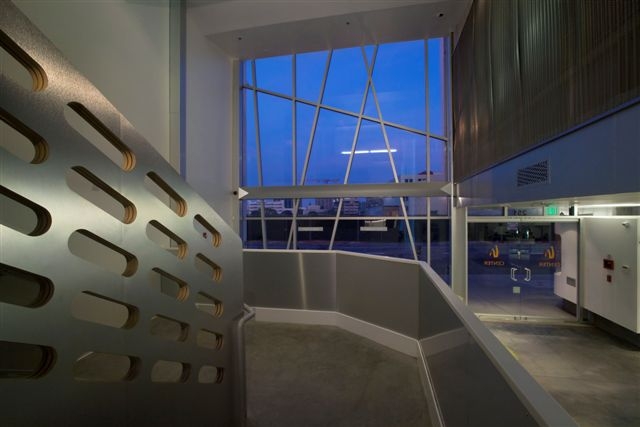



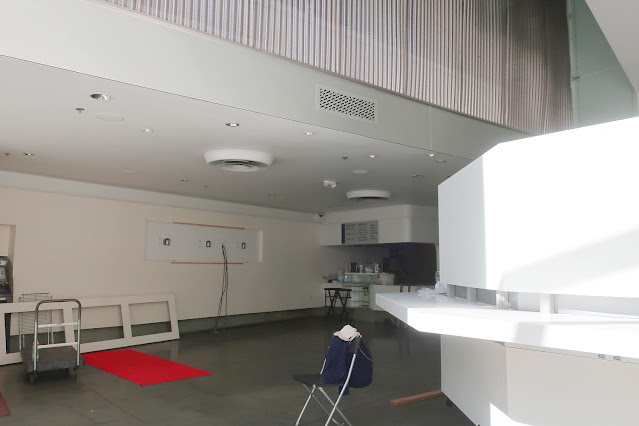



















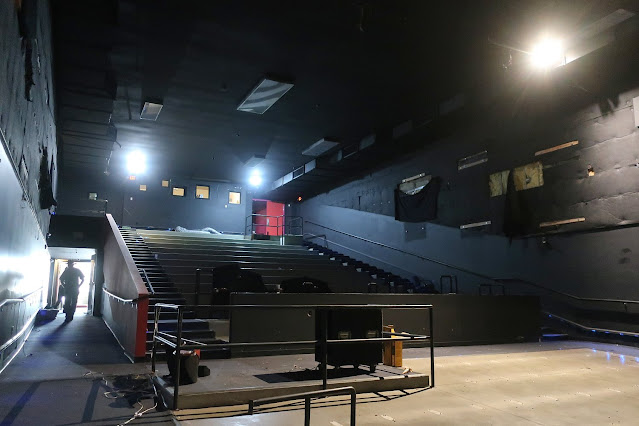

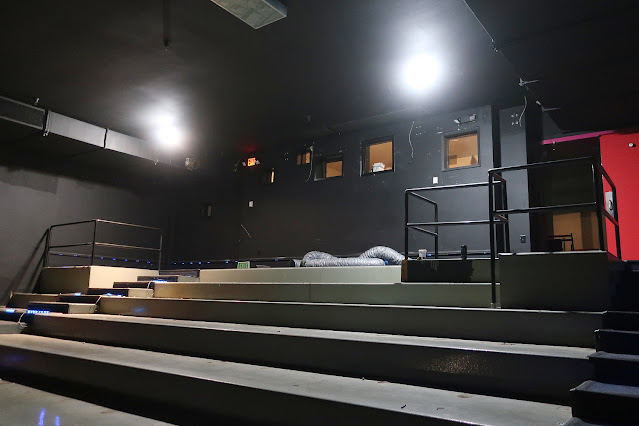


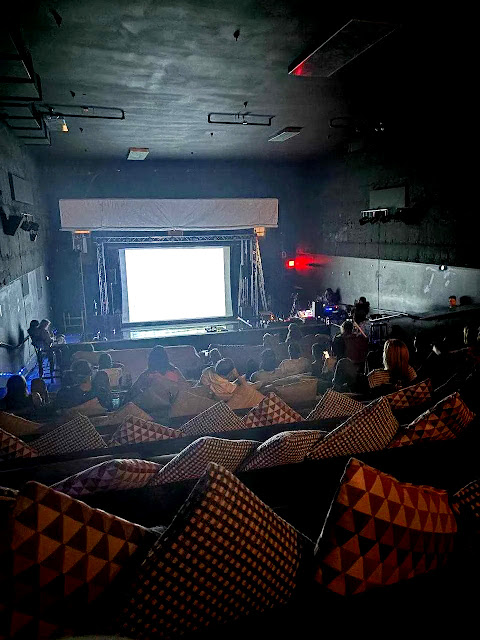






























































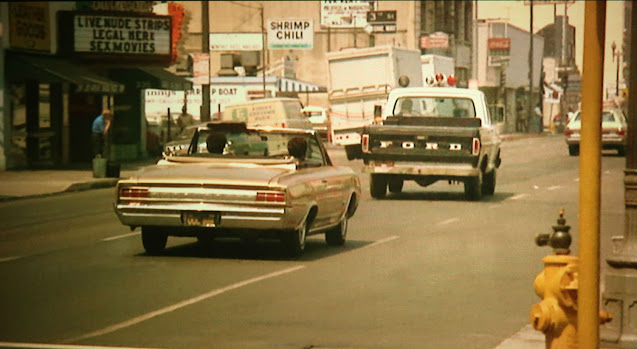

The recent Shudder channel documentary HORROR NOIRE features multiple interviews and scenes of actors, directors, and historians watching films inside the Downtown Independent auditorium.
ReplyDeleteThanks, Marc.
DeleteA wonderful success story. Thank you!
ReplyDeleteGreat read! Thanks for posting. I'll miss this theater.
ReplyDelete